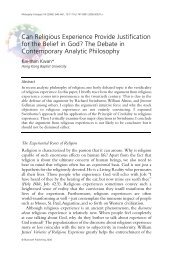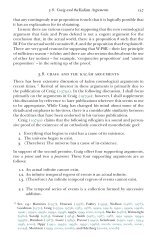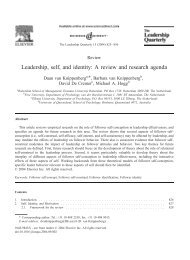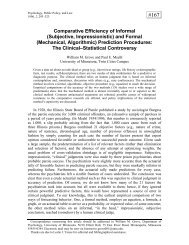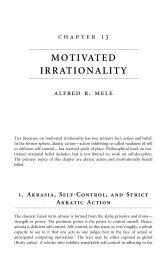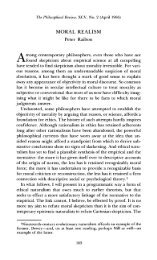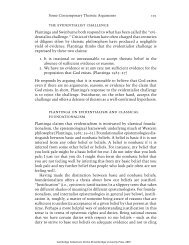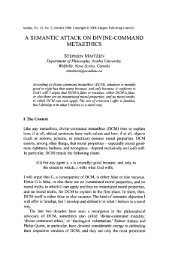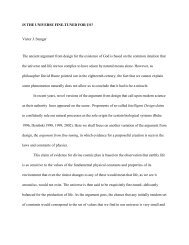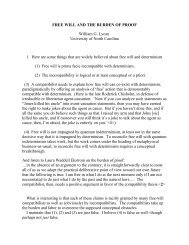Atheism and Theism JJ Haldane - Common Sense Atheism
Atheism and Theism JJ Haldane - Common Sense Atheism
Atheism and Theism JJ Haldane - Common Sense Atheism
You also want an ePaper? Increase the reach of your titles
YUMPU automatically turns print PDFs into web optimized ePapers that Google loves.
196 J.J.C. Smart <strong>and</strong> J.J. <strong>Haldane</strong><br />
The deployment of this fact in reply to Putnam <strong>and</strong> others needs to be<br />
adapted according to variations in the way in which epistemological assumptions<br />
feature in their critiques of realism, but we are agreed on it as a general<br />
point of response. Where we differ is over the issue of plurality as that enters<br />
Putnam’s argument from conceptual relativity. One way of reading the relativity<br />
claim is as another instance of epistemological seepage into ontology.<br />
And if it is understood as the argument that since all thought is conceptually<br />
structured therefore all we ever think of are conceptual structures, it is easily<br />
dismissed. First, because it does not follow from the fact that we think with<br />
concepts that concepts are what we think of ; 5 second, because even if that did<br />
follow it would not impugn the mind-independence of reality but only provide<br />
a basis for scepticism.<br />
However, there is another way of regarding Putnam’s insistence on conceptual<br />
relativity <strong>and</strong> that is as the shadow cast upon epistemology by the<br />
metaphysical claim that reality is radically pluralistic <strong>and</strong> hence not such as<br />
to be adequately characterized by one style of description, in particular that of<br />
basic physical theory. Conceptual relativity is thus the claim that there is no<br />
single correct scheme for describing reality precisely because reality itself is<br />
not ‘monomorphic’ or reducible to a single level of nature. Smart writes:<br />
Putnam wants ‘realism’ with a human face, but I want to see the world sub specie<br />
aeternitatis (realism with a cosmic face?), by which I mean that we should<br />
eschew indexical expressions in our description of reality, <strong>and</strong> also eschew such<br />
concepts as that of colour, which are defined in terms of a normal human<br />
percipient . . . I can agree with Putnam that causation <strong>and</strong> other concepts in<br />
ordinary life are highly contextual <strong>and</strong> dependent on particular human interests.<br />
I can relegate them to what Quine calls ‘second grade discourse’, not suitable<br />
for metaphysics but highly convenient for our ordinary human practical activities<br />
<strong>and</strong> social intercourse. 6<br />
Putnam’s easily predictable response to this is that no good case can be<br />
made for relegating intentional, evaluative <strong>and</strong> other non-scientific characterizations<br />
to the realm of ‘second grade discourse’. However, in order to deny<br />
truth-bearing priority to physical theory over psychological or moral description<br />
he thinks it is necessary to diversify ‘reality’ by relativizing the ‘real’ to<br />
a plurality of ways of thinking. Like Putnam, <strong>Haldane</strong> wishes to insist upon<br />
the ontological reality of the biological, the psychological <strong>and</strong> so on – as well<br />
as the physical – but to do so while remaining a metaphysical realist. That is,<br />
he regards these domains as ‘populated’ in various ways <strong>and</strong> to various extents<br />
independently of our conception of them: biological <strong>and</strong> psychological properties<br />
are there to be discovered <strong>and</strong> described <strong>and</strong> are not functions of our modes<br />
of description. As he writes elsewhere:



